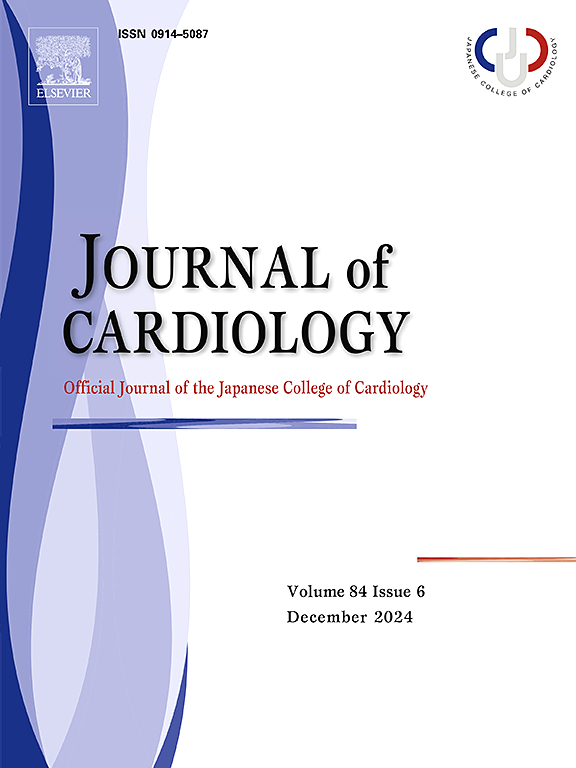The difference of gas exchange pulmonary arterial capacitance with postural change between chronic thromboembolic pulmonary hypertension and pulmonary arterial hypertension
IF 2.5
3区 医学
Q2 CARDIAC & CARDIOVASCULAR SYSTEMS
引用次数: 0
Abstract
Background
Pulmonary artery compliance (PAC), which could be estimated with gas exchange pulmonary arterial capacitance (GXcap), reflects the elasticity of the pulmonary vessels, and it is known that PAC is changed by pulmonary perfusion. GXcap could be measured using ventilatory gas analysis and is calculated using O2 pulse × peak end-tidal CO2 pressure. Moreover, it is known that pulmonary perfusion by postural changes is different between chronic thromboembolic pulmonary hypertension (CTEPH) and pulmonary arterial hypertension (PAH). However, it was unclear whether GXcap could estimate PAC in CTEPH and PAH. Furthermore, it was unclear that change in GXcap with postural change (ΔGXcap) [Δ (Sitting - Supine)] was different between CTEPH and PAH.
Methods
Patients with suspected pulmonary hypertension who underwent right heart catheterization (RHC) from May 2022 to February 2023 in our institution were prospectively enrolled. Ventilatory gas analysis was performed before RHC in both the supine and sitting positions and calculated. Moreover, PAC was calculated with RHC. The diagnosis of PAH and CTEPH was based on the European Society of Cardiology/European Respiratory Society 2022 guidelines.
Results
Forty patients (CTEPH, n = 18; PAH, n = 22) were enrolled in this study. GXcap was positively related to PAC in these patients (R = 0.62, p < 0.001). Furthermore, PAC was significantly lower in CTEPH patients compared to PAH patients (median 1.63 mL/mmHg vs 2.05 mL/mmHg, p = 0.013). Moreover, GXcap was increased in CTEPH patients with postural change, while GXcap was decreased in PAH patients with postural change. Thus, ΔGXcap was significantly higher in CTEPH patients compared to PAH patients (median 5.8 mL × mmHg vs −2.6 mL × mmHg, p = 0.005).
Conclusions
It was suggested that PAC could be moderately estimated using GXcap in PAH and CTEPH patients. Moreover, it was suggested that ΔGXcap was higher in CTEPH patients compared with PAH patients.

慢性血栓栓塞性肺动脉高压与肺动脉高压气体交换肺动脉电容随体位变化的差异。
背景:肺动脉顺应性(Pulmonary artery compliance, PAC)反映了肺血管的弹性,可以通过气体交换肺动脉电容(gas exchange Pulmonary arterial capacitance, GXcap)来估计,已知PAC会随着肺灌注的改变而改变。GXcap可以通过通风气体分析来测量,并通过O2脉冲×峰值潮汐末CO2压力来计算。此外,众所周知,体位改变引起的肺灌注在慢性血栓栓塞性肺动脉高压(CTEPH)和肺动脉高压(PAH)之间是不同的。然而,GXcap是否能够估计CTEPH和PAH中的PAC尚不清楚。此外,尚不清楚GXcap随体位变化(ΔGXcap) [Δ(坐姿-仰卧位)]的变化在CTEPH和PAH之间是否不同。方法:前瞻性纳入2022年5月至2023年2月在我院行右心导管(RHC)术的疑似肺动脉高压患者。在RHC前进行仰卧位和坐位的通气气体分析并计算。用RHC计算PAC。PAH和CTEPH的诊断基于欧洲心脏病学会/欧洲呼吸学会2022指南。结果:40例患者(CTEPH, n = 18;PAH, n = 22)被纳入本研究。GXcap与PAH和CTEPH患者的PAC呈正相关(R = 0.62,p )结论:GXcap可以适度估计PAH和CTEPH患者的PAC。此外,CTEPH患者的ΔGXcap高于PAH患者。
本文章由计算机程序翻译,如有差异,请以英文原文为准。
求助全文
约1分钟内获得全文
求助全文
来源期刊

Journal of cardiology
CARDIAC & CARDIOVASCULAR SYSTEMS-
CiteScore
4.90
自引率
8.00%
发文量
202
审稿时长
29 days
期刊介绍:
The official journal of the Japanese College of Cardiology is an international, English language, peer-reviewed journal publishing the latest findings in cardiovascular medicine. Journal of Cardiology (JC) aims to publish the highest-quality material covering original basic and clinical research on all aspects of cardiovascular disease. Topics covered include ischemic heart disease, cardiomyopathy, valvular heart disease, vascular disease, hypertension, arrhythmia, congenital heart disease, pharmacological and non-pharmacological treatment, new diagnostic techniques, and cardiovascular imaging. JC also publishes a selection of review articles, clinical trials, short communications, and important messages and letters to the editor.
 求助内容:
求助内容: 应助结果提醒方式:
应助结果提醒方式:


